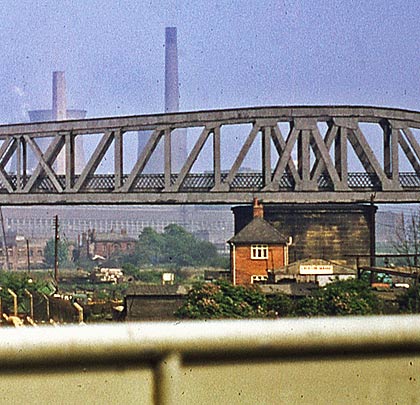Knowsthorpe swing bridge
Knowsthorpe swing bridge


















In 1893, a number of engineering firms in Hunslet, Leeds, obtained an Act of Incorporation for the Hunslet Railway Company, with the aim of establishing local facilities for the handling of their goods, dissatisfied with those afforded by the Great Northern Railway at Wellington Street, two miles away. The GN saw several benefits in this scheme and, a year later, took the company over.
Plans for the line were prepared by W B Myers-Beswick – a regular servant of the Great Northern – whilst the works were contracted to J T Firbank of London. The main line was 3¼ miles in length, but the vast goods yards near South Accommodation Road pushed this distance to four miles.
Much of the track was laid on embankments, material for which was brought from eight pit heaps, some as far as three miles away. But the principal engineering feat was a six-span bridge over the Aire & Calder Navigation and adjacent River Aire at Knowsthorpe (or Knostrop). As a concession to the waterway’s authorities, it was agreed that the span over the Navigation should be constructed in such a way that a swing mechanism could subsequently be installed, thus accommodating plans for the possible formation of a ship canal into Leeds.
The resulting structure was vast: a clear span of 170 feet across the waterway and 275 feet between abutments. The two main girders, 41 feet apart, extended for 295 feet, with a depth of 30 feet. The weight of their steelwork amounted to 1,250 tons. The ashlar column supporting the main span was 45 feet in diameter whilst the foundations for the piers were sunk to a depth of 35 feet. To test the span’s strength prior to the line’s opening, the free end was jacked up, the support rollers and bed plates removed, then the deflection was recorded as the jacks were gently lowered. To counterbalance the forces exerted on the long arm when loaded, a weight of 157 tons had to be applied to the short arm. This was achieved by boxing in its main and cross girders, thereafter filling them with cast iron.
Work on the structure got underway in January 1897, under the auspices of Darlington’s Cleveland Bridge & Engineering Company, the appointed subcontractor. Three men lost their lives during its assembly and two others sustained injuries.
Immediately beyond the main span were two short steel-deck sections over a narrow ribbon of land separating the Navigation and river. The latter was crossed by a pair of bowstring girder spans supported by a pier standing in the water. The track over the bridge ascended on a gradient of 1:100 to the south, with the structure incorporating a curve of 25 chains in radius.
Leeds’ ship canal never came to fruition and the main span was never adapted to swing. The line over it closed on 3rd January 1966, although the section from Beeston Junction to Middleton Colliery exchange sidings was retained until 3rd July 1967. At the north end, Neville Hill-Hunslet East Goods officially remains open but very rarely sees traffic.
Ogden Demolition dismantled the bridge in 1977, leaving only the masonry column for the swing span, the northern abutment and the mid-river pier.
(Christine Johnstone and Dr Neil Clifton’s photos, taken from Geograph, are used under this Creative Commons licence.)







